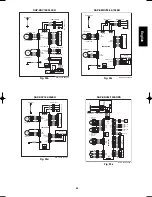
18
English
!
Pump Down
"
When relocating or disposing of the Air Conditioner, request
this service from the dealer where the unit was purchased,
or from an appropriate agent. Perform pump-down as
described below.
What is pump-down?
"
Pump-down refers to recovering the refrigerant gas from the
refrigerant cycle at the outdoor unit. This work must be
performed during cooling operation. The refrigerant gas
cannot be recovered during heating operation.
"
During winter, or if the temperature sensor prevents cooling
operation, perform “forced cooling operation.”
Pump-down procedure
(1) Fully close the spindles at the valves on the narrow tube
side of tubes A, B, C and D. (Refer to Fig. 22.)
(2) Connect the manifold gauge to the charging port at the valve
on the wide tube side of tube D. Purge the air from the
charging hose. (Refer to Fig. 23.)
(3) Perform cooling operation or forced cooling
operation.
When the pressure at the low-pressure side is 0.15 – 0.2
MPa (0.5 – 1 kg/cm
2
G), fully close the spindles at the
valves on the wide tube side of tubes A, B, C and D, and
immediately stop operation. (Refer to Fig. 23.)
In the winter, the outdoor unit may stop after 5 - 10 minutes
of operation. This is in order to protect the indoor unit heat
exchanger from freezing and does not indicate a problem.
(4) Disconnect the manifold gauge and the inter-unit tubes,
and attach the caps and flare nuts. At this point, pump-
down is completed. (If the caps and flare nuts are not
reattached, there is the danger of gas leakage.) (Refer to
Fig. 24.)
If pump-down is not possible
If the Air Conditioner cannot be operated because of a
malfunction or other cause, use a refrigerant recovery
device to recover the refrigerant.
In order to protect the earth’s environment, be sure to perform pump-down to recover refrigerant
gas without releasing it into the atmosphere.
Fig. 22
(11) Replace the flare nut on the wide tube service port and fasten the flare nut securely with an adjustable wrench or
box wrench. Next, mount the valve cap and tighten it with a torque wrench (the cap needs to be tightened with the
torque of 20 N·m (200 kgf · cm)). This process is very important to prevent gas from leaking from the system.
(12) Test run the air conditioner. (See page 23.)
(13) While the air conditioner is running, apply liquid soap to check for any gas leaks around the service valves or caps.
(14) If there is no leakage, stop the air conditioner.
(15) Wipe off the soap on the tubing.
This completes air purging with a vacuum pump and the air conditioner is ready for actual operation.
Fig. 23
C
D
B
A
Manifold gauge
Wide tube side
Cap
Cap
Cap
Cap
After disconnecting
the inter-unit tubes,
attach the flare nuts
with flare bonnets.
Fig. 24
D
C
B
A
Charging port
Narrow tube side
Close
Close
Close
Close
08-253 CMRV3146EH_OU EN 10/14/08 2:39 PM Page 18











































